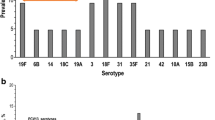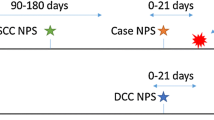Abstract
Objective
To study the naso-pharyngeal carriage of organisms in children diagnosed with severe pneumonia.
Methods
Nasopharyngeal aspirate and swabs for microbiological analyses were collected from 377 children aged 3–59 months with severe pneumonia.
Results
28.6% of the samples were positive for S. pneumoniae, 9.6% were positive for H. influenzae, and 8.5% were positive for both the organisms. Respiratory syncytial virus was detected in 27% of samples. The rate of isolation of S. pneumonia and H. influenzae was significantly more in the age group of 12–59 months.
Conclusions
In children with severe pneumonia, most common organisms isolated/detected from naso-pharyngeal aspirates were S.pneumoniae and Respiratory Syncytial Virus.
Similar content being viewed by others
References
Walker CL, Rudan I, Liu L, Nair H, Theodoratou E, Bhutta ZA, et al. Global burden of childhood pneumonia and diarrhoea. Lancet. 2013;381:1405–16.
Kabra SK, Lodha R, Broor S, Chaudhary R, Ghosh M, Maitreyi RS. Etiology of acute lower respiratory tract infection. Indian J Pediatr. 2003;70:33–6.
Agarwal G, Awasthi S, Kabra SK, Kaul A, Singhi S, Walter SD, ISCAP Study Group. Three day versus five day treatment with amoxicillin for non-severe pneumonia in young children: A multicentre randomised controlled trial. BMJ. 2004;328:791.
GV D. Susceptibility of Test of Fastidious bacteria. 6th ed. Washington: American Society for American Microbiology; 1995.
Clinical and Laboratory Standards Institute. Performance Standards for Antimicrobial Susceptibility Testing; Seventeenth Informational Supplement: Clinical and Laboratory Standards Institute, 940 West Valley Road, Suite 1400, Wayne, Pennsylvania 19087–1898 USA, 2007. CLSI document M100-S17.
Jain A, Kumar P, Awasthi S. High nasopharyngeal carriage of drug resistant Streptococcus pneumoniae and Haemophilus influenzae in North Indian schoolchildren. Trop Med Int Health. 2005;10:234–9.
Patwari AK, Bisht S, Srinivasan A, Deb M, Chattopadhya D. Aetiology of pneumonia in hospitalized children. J Trop Pediatr. 1996;42:15–20.
Broor S, Parveen S, Bharaj P, Prasad VS, Srinivasulu KN, Sumanth KM, et al. A prospective three-year cohort study of the epidemiology and virology of acute respiratory infections of children in rural India. PLoS One. 2007;2:e491.
Gupta S, Shamsundar R, Shet A, Chawan R, Srinivasa H. Prevalence of respiratory syncytial virus infection among hospitalized children presenting with acute lower respiratory tract infections. Indian J Pediatr. 2011; 78:1495–7.
Hemalatha R, Swetha GK, Seshacharyulu M, Radhakrishna KV. Respiratory syncitial virus in children with acute respiratory infections. Indian J Pediatr. 2010;77:755–8.
Rajala MS, Sullender WM, Prasad AK, Dar L, Broor S. Genetic variability among Group A and B respiratory syncytial virus isolates from a large referral hospital in New Delhi, India. J Clin Microbiol. 2003;41:2311–6.
Singh AK, Jain A, Jain B, Singh KP, Dangi T, Mohan M, et al. Viral aetiology of acute lower respiratory tract illness in hospitalised paediatric patients of a tertiary hospital: one year prospective study. Indian J Med Microbiol. 2014;32:13–8.
Levine OS, Liu G, Garman RL, Dowell SF, Yu S, Yang YH. Haemophilus influenzae type b and Streptococcus pneumoniae as causes of pneumonia among children in Beijing, China. Emerg Infect Dis. 2000;6:165–70.
Invasive Bacterial Infections Surveillance (IBIS) Group of the International Clinical Epidemiology Network. Are Haemophilus influenzae infections a significant problem in India? A prospective study and review. Clin Infect Dis. 2002;34:949–57.
Kumar KLR, Ganaie F, Ashok V. Circulating serotypes and trends in antibiotic resistance of invasive Streptococcus pneumoniae from children under five in Bangalore. J Clin Diagn Res. 2013;7:2716–20.
Author information
Authors and Affiliations
Rights and permissions
About this article
Cite this article
Singh, M., Agarwal, A., Ranjan Das, R. et al. Naso-pharyngeal carriage of organisms in children aged 3–59 months diagnosed with severe community-acquired pneumonia. Indian Pediatr 53, 125–128 (2016). https://doi.org/10.1007/s13312-016-0805-4
Received:
Revised:
Accepted:
Published:
Issue Date:
DOI: https://doi.org/10.1007/s13312-016-0805-4




